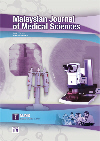
|
Malaysian Journal of Medical Sciences
School of Medical Sciences, Universiti Sains Malaysia
ISSN: 1394-195X
Vol. 15, No. 1, 2008, pp. 4-12
|
 Bioline Code: mj08002
Bioline Code: mj08002
Full paper language: English
Document type: Review Article
Document available free of charge
|
|
|
Malaysian Journal of Medical Sciences, Vol. 15, No. 1, 2008, pp. 4-12
| en |
An Overview of Bone Cells and their Regulating Factors of Differentiation
Mohamed, Alizae Marny
Abstract
Bone is a specialised connective tissue and together with cartilage forms the strong and rigid endoskeleton. These tissues serve three main functions: scaffold for muscle attachment for locomotion, protection for vital organs and soft tissues and reservoir of ions for the entire organism especially calcium and phosphate. One of the most unique and important properties of bone is its ability to constantly undergo remodelling even after growth and modelling of the skeleton have been completed. Remodelling processes enable the bone to respond and adapt to changing functional situations. Bone is composed of various types of cells and collagenous extracellular organic matrix, which is predominantly type I collagen (85-95%) called osteoid that becomes mineralised by the deposition of calcium hydroxyapatite. The non-collagenous constituents are composed of proteins and proteoglycans, which are specific to bone and the dental hard connective tissues. Maintenance of appropriate bone mass depends upon the precise balance of bone formation and bone resorption which is facilitated by the ability of osteoblastic cells to regulate the rate of both differentiation and activity of osteoclasts as well as to form new bone. An overview of genetics and molecular mechanisms that involved in the differentiation of osteoblast and osteoclast is discussed.
Keywords
Bone cells, osteoblasts, osteoclasts, regulations
|
| |
© Copyright 2007 - Malaysian Journal of Medical Science
Alternative site location: http://www.medic.usm.my/publication/mjms/
|
|
